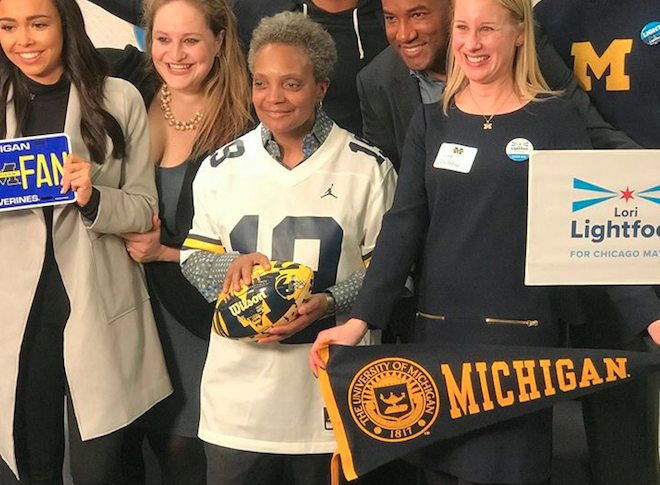Late last year, after Illinois beat Michigan State 37–34 at Spartan Stadium, the Twitter feed @LansingMIFacts had this reaction: “That Michigan State football game was weird because usually the only thing we lose to Illinois is recent graduates.”
I laughed, not only because I was once one of those graduates, but because that single sentence encapsulates the relationship between Michigan and Illinois, which have gone from independently equal industrial states to combative codependents.
When I was growing up in Michigan in the ’70s and ’80s, my family never visited Chicago. We didn’t look to it as “the big city.” We had Detroit, with its own big department store (Hudson’s), its own big radio station (WJR), its own sports teams (unfortunately, the Lions), and its own concert venues. As an aspiring journalist, my ambition was not to write for Chicago magazine, but for the Detroit Free Press, the newspaper I delivered every cold-ass morning.
A lot has changed since then. When I was born, Detroit’s population was 1.5 million; it’s dropped to around 650,000 today. In 1970, Michigan’s per capita income was equal to the national average. Now, it’s 88 percent of the current average, and Michigan ranks 33rd in overall prosperity.
Illinois ranks 16th, in part because, according to USA Today, “Chicago is … one of the country’s major hubs for business. This may be a reason why an outsized share of Illinois households — 7.5 percent — earn more than $200,000.”
Currently, Illinois is where the money is. In the 1990s, most of my friends were moving to Chicago, so I followed them. Like previous waves of transplants, we brought with us the traditions of our home state (you may have noticed the dozen Michigan and Michigan State bars in Lake View and Lincoln Park). The North Side was populated by so many Michiganders, I started calling it “Michago.” Even our mayor is a Michigan grad.
What happened? Chicago successfully transitioned from an industrial manufacturing city to a global metropolis, while Detroit bonked that move. In the 1980s, when the steel mills were closing on the Southeast Side, and black and white aldermen were warring over shrinking resources, Chicago looked like it was headed for the same fate as every other Rust Belt city. A 1981 Tribune editorial said the city was “being eaten away by economic forces as powerful as those that thrust it upward out of the marshes more than a century ago.”
But, as it turned out, Chicago was better prepared than Detroit for a knowledge-based economy. As the headquarters of the Mercantile Exchange and the Board of Trade, it was the Midwest’s clear financial center, and as America’s transportation hub, it was a plum location for consulting businesses that flew employees all over the country. As I wrote in my 2013 book Nothin’ But Blue Skies, in 1986, Chicago’s ad agencies, investment banks, law firms, benefits consultants, accountants, and management consultants employed 17,000 people. A little more than a decade later, they employed 60,000.
The 2000s, which are remembered as Michigan’s “Lost Decade,” accelerated the exodus of young Michiganders to Chicago. Since 2000, Michigan has lost half its automaking jobs — the cornerstone of the state’s prosperity. In 2000, a quarter of Michigan State University graduates left the state. By 2010, half were leaving, and the city with the most recent graduates was… Chicago.
Over the same time period, Michigan dropped from 30th to 35th among US states for its percentage of residents with a college degree (it’s since moved up to 34). Illinois ranks 13th. According to the Illinois Department of Commerce, there are 25,000 Michigan State graduates and 23,000 Michigan graduates living in Illinois.
If native Chicagoans are annoyed by transplants from Michigan, the feeling is mutual across the lake. In western Michigan, locals call the summer vacationers FIPs, or Fucking Illinois People. The Daley family has a cottage in Grand Beach, just over the state line. Every weekend in August, gleaming Escalades with Illinois plates pull up to Oink’s ice cream stand in New Buffalo, a favorite of lifelong FIP Roger Ebert. Further up the shore, Saugatuck is Boystown North.
Not only is Illinois grabbing Michigan’s college graduates, it’s grabbing Michigan’s best real estate, too. The Lake Michigan beaches are the state’s most beautiful landscapes, but wealthy FIPs hog all the good lakefront property, from New Buffalo up to Harbor Springs (where they’re known as fudgies, for their patronage of Kilwin’s Fudge Shop). After all, nobody would vacation on an Illinois beach, with its harsh sunrise and hard pebbles.
Michigan gets revenge by allowing school districts to tax vacationers’ homes at four times the rate of locals’. New Buffalo schools are funded by FIPs.
Chicago is no longer just Illinois’s big city. It’s the Midwest’s big city. In our global era, money and education have become concentrated in fewer places. Chicago is the regional capital, the magnet for ambitious Midwesterners. All those green-and-white S’s and maize-and-blue M’s flapping in front of taverns are the price of its success.



